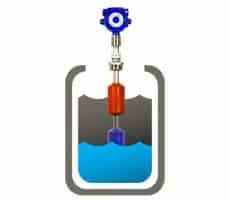 In a recent article (1/29/2013), Walt Boyes of Control Global discussed level applications from the dark side – that is, level measurements that are extremely difficult and may be impossible. His general conclusions are very accurate; some level measurements are simply impossible, and others may not be worth it.
In a recent article (1/29/2013), Walt Boyes of Control Global discussed level applications from the dark side – that is, level measurements that are extremely difficult and may be impossible. His general conclusions are very accurate; some level measurements are simply impossible, and others may not be worth it.
This article is really in response to his final example of a difficult level measurement – interface level. Boyes mentions capacitance, admittance, radar, nuclear, and sight glasses as possible level sensor technology that can detect an interface between two liquids. In this article, we’d like to show you how magnetostrictive level sensors are perfect for interface level sensing.
For interface level measurements, magnetostrictive level sensors use two floats, one for the top level, and one for the interface level. The floats have a specific gravity that is slightly lighter than the liquid they measure. So for the classic oil/water interface, which we do a lot of, the oil float has a specific gravity (SG) around 0.65, while the water float has an SG around 0.95.
Using floats with a fine-tuned specific gravity works very well for oil and water. However, in the interest of full disclosure, this becomes difficult when oil and water mix (or other immiscible liquids). This is known as a rag layer. The problem with rag layers is that they are irregular.
For example, in a tank with a 10’ diameter, an inlet on one side will create a lot of churn on that side while the other side may be quite calm. In addition, the liquids don’t really mix, but mingle – meaning they exist next to each other in globs. It’s more of a salad bowl, not a melting pot.
Boyes defines a rag layer as, “a miscible layer where the material in the bottom level mixes irregularly with the material in the top layer.”
The good news is, that with the right SG, a float will sink until it reaches the denser liquid – in this case, water. You should at least be able to see the bottom of the rag layer at the point of measurement. So while the rag layer is irregular, the float will behave consistently.
All that said, rag layers are not a real problem for a lot of interface level measurements. In storage tanks where water has yet to be separated from oil or condensate, the two layers are allowed to settle before they need to be pumped out. The water is often removed as it accumulates, and taken to a treatment facility.
In applications where the liquids are not allowed to settle, then a rag layer will certainly make the level interface impossible to measure. Just like measuring the level of a vortex, a rag layer destroys a clear level and you begin to guess what it should be.
As with anything, the application and its goals come first. Once you understand the level application and the specifications for the sensor, then you can go about the sensor selection process. This may lead you to such technologies as radar, admittance, capacitance, or even nuclear, but they’re far from your only options.
Boyes has created a very useful tool called the Level Continuum, that shows several level measurement technologies and how they stack up as measurement applications get more technically difficult. Check it out for a great overview. Just keep in mind that it is not, and was probably never meant to be, an exhaustive list of all your options.
Often, the simplest answer is the best, and that will usually take you in the direction of a pressure transmitter, or perhaps a magnetostrictive probe. Both are far less expensive than a radar level sensor, at least that’s been our experience.
Let us know if you have any questions about interface level measurement or magnetostrictive level sensor technology. We’re always happy to help, and we’ll even concede to radar when it’s truly the best option for you ☺!